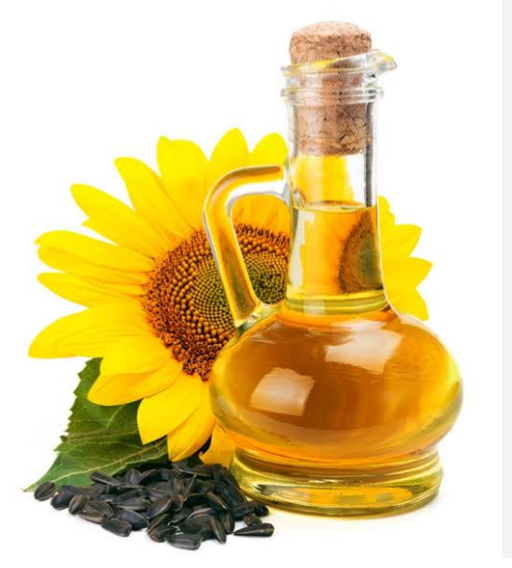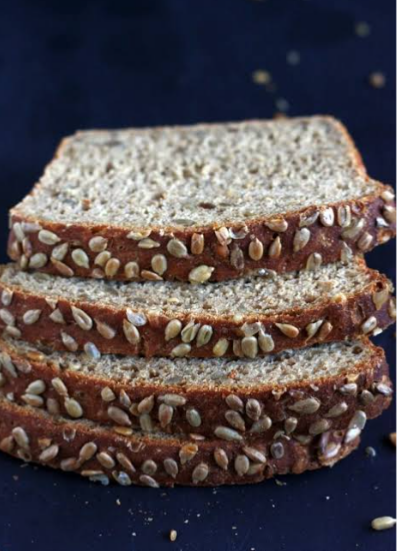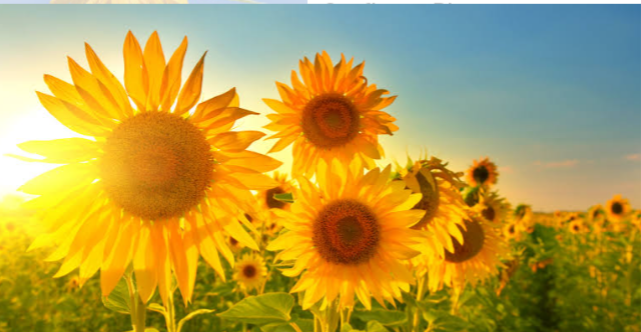
Sunflower are the types of plants with large bright yellow petals known as ray flowers and distinctive dark centre where the seeds are formed. They belong to the family (Asteraceae) and genus helianthus. There are about 70 species of sunflower. Most of the species are perennial, while few are annual species They are mainly cultivated for their ornamental values and seeds ( used for food, feed and oil).The common sunflower (Helianthus annuus) is the mostly cultivated species. It is also called sonneblomThe flower of sunflower is a pseudanthium, or flowerhead, made up of many small flowers. It has ability to track the movement of sun. The flower faces east in the morning and as the sun sets, it changes direction to the west. And east again in the morning. Meaning it moves with accordance to the path of the sun. This mean the plant is a heliotropic plant. Note that only immature sunflower buds move from east to west, the mature flowers permanently face east.The plant has a green erect stem covered in coarse hairs. The leaves are broad, with serrated edges, and are alternately arranged on the stem. The multiple petals are fused together. Some produce petals that are red or orange in colour. The black-brown flowers in the centre of the head is called disk flowers. Over time, the disc flowers mature to form the sunflower seeds (achene). The fruit is a single-seeded achene.
FUNCTIONS OF THE PARTS OF SUNFLOWER PLANT.
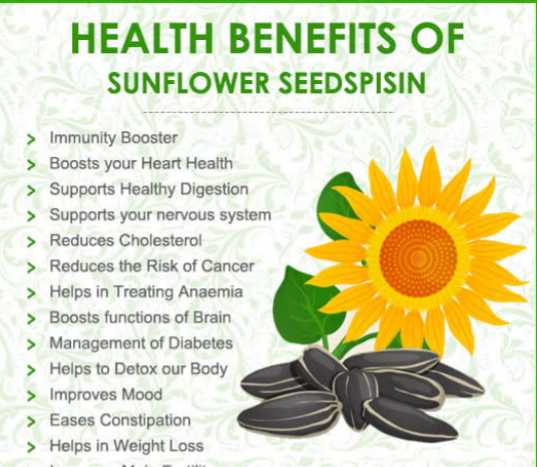
1. The leaves are used as fodder. 2. The yellow flowers are used for making yellow dye, 3. The seeds contain oil and are used for food.The seeds may be eaten dried, roasted, or ground into nut butter and are common in birdseed mixes. The seed oil can be processes into sunflower butter and margarine. 4. The seeds are also used to feed animals like poultry. 5. Sunflower oil cake is used for stock and poultry feeding. 6. The oil is also used in soap and paints and as a lubricant. 7. Some tribes some countries uses sunflower as a symbol to represent their various sun gods. And Ukraine uses the symbol of sunflower as their national flower because they are one of the largest producers of sunflower. 8. Sunflower petals are edible, but due to their flavour, majority of people dispise eating them 9. Sunflower seed husks are used as animal feed. 10. Sunflower oil can be mixed with diesel to produce bio fuel. 11. Sunflower seeds contain vitamin E, magnesium, protein, linoleic and fatty acids which help lower blood pressure, cholesterol and blood sugar level. 12. Vitamin and E and Flavonoids in sunflower seeds help reduce inflammation. 13. The magnesium in sunflower seeds helps reduce blood pressure levels by blocking the enzyme that causes blood vessels to constrict and make them relax, lowering blood pressure level. 14. Chlorogenic acid in sunflower seed is found to lower blood sugar level and type 2 diabetes.
TYPES OF SUNFLOWER
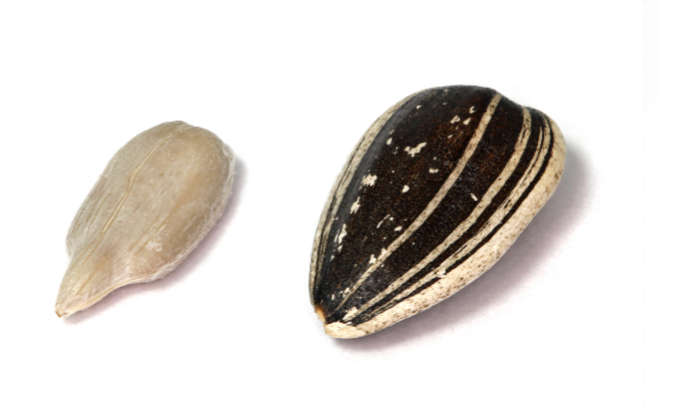
There are two main types of sunflower crops . 1. One grown for the seeds eaten, 2. The other farmed for the oil.
SUNFLOWER GROWN FOR SEED .
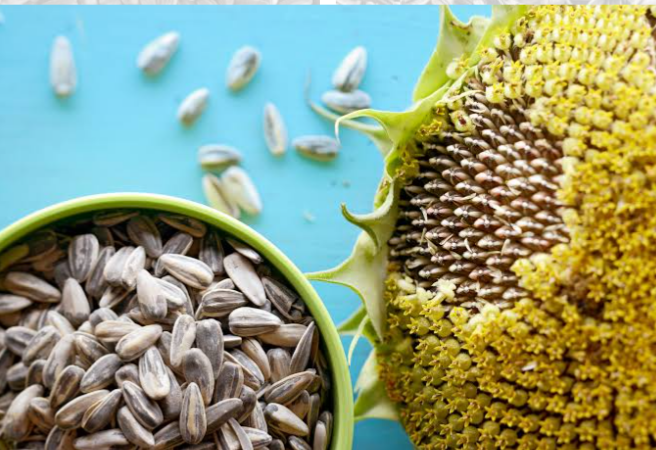
Sunflower seeds are technically the fruits of the sunflower plant (Helianthus annuus). The seeds are harvested from the plant’s large flower heads. A single sunflower head may produce up to 2,000 seeds. The nonoil sunflower are called the confection sunflower. The edible seeds are encased in inedible black-and-white striped shells called hulls. While those used for extracting sunflower oil have solid black shells. The seeds have thick hull that remains loosely attached to the kernel. This brings about complete dehulling. The seeds are larger than that of the oilseed types and has a lower oil percentage.
SUNFLOWER SEED NUTRITIONAL CONTENT AND THEIR VALUES IN GRAMS AND %. 1. The following are the nutrient content in a seed of sunflower: Saturated fat 1.5 grams, Polyunsaturated fat 9.2 grams , Monounsaturated fat 2.7 grams , Protein 5.5 grams , Carbs 6.5 grams , Fiber 3 grams , Vitamin E 37%, Niacin10%, Vitamin B6 11%, Folate 17%, Pantothenic acid 20%, Iron 6%, Magnesium 9%, Zinc 10%, Copper 26%, Manganese 30%, Selenium 32%. 2. The seed has high amount of vitamin E and selenium. Both are antioxidants which protect the body cells against free radical damage. 3. The seed also contain phenolic acids and flavonoids which are also antioxidants. 4. Sunflower seed is rich in fats (that is, polyunsaturated fat and monounsaturated fat) which reduces the rates of cardiovascular disease, high cholesterol, and high blood pressure. 5. Sunflower seeds are good source of vitamins and minerals that can support the immune system and increase the ability of the body to fight against viruses. Zinc plays an important role in the immune system, aid the development of immune cells. Selenium assist in reducing fighting against infection, and boost immune system. 6. protein, vitamin B2 (thiamin), and Selenium, help boost body energy levels.
SUNFLOWER GROWN FOR OIL.
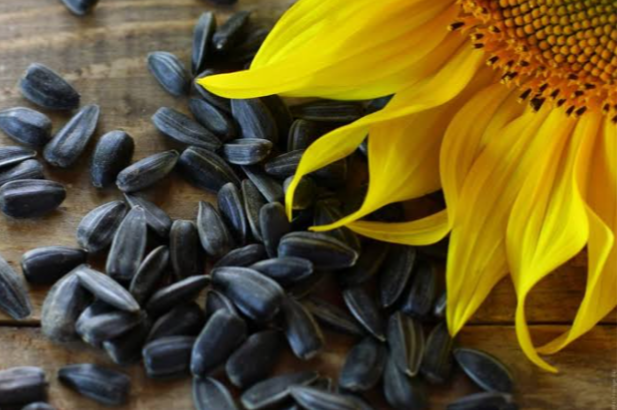
Sunflowers are a major source of vegetable oil in the world. The seeds are small with high oil percentage. The oilseed hybrids are sources of three fatty acid types: linoleic, mid-oleic (NuSun) or high oleic. They are usually black seeded and have a thin hull that adheres to the kernel. This makes it difficult to dehull the shell from the kernel. AGRONOMIC PRODUCTION PRACTICES OF SUNFLOWER. 1. CHOOSE A SUNNY LOCATION : Sunflower needs full sun. They need atleast 8 to 10 hours of sunlight per day. 2. SOIL PREPARATION : A well-drained, high water-holding capacity soils, rich in organic matter is required. The pH of the soil should be near neutral (pH 6.5-7.5). Every stone and plant twigs should be removed from the soil. Seeds should be sown at a depth of 12 inches deep. 3. PLANT SPACING: Sunflower plant should be spaced between 1 to 2 inches apart and 6 to 12 inches between rows. 4. CROP ROTATION: Sunflower can be rotated with other crops to prevent yield-reducing problems such as:Disease and disease-infestion, insect pest infection, Increased populations of weeds, andSoil moisture depletion etc. It can be rotated with cowpea and soybean. 5. WATER REQUIREMENT: The soil should be kept moist and not waterlogged. Source of water can be rain or irrigation water. 6. FERTILIZATION: fertilisers should be applied on regular as they support sunflower growth. This will make the plant to gain strength and not fall over. Therefore, staking or trailing materials are needed to support the long stem from logging. 7. SEED HARVESTING : The seeds are ready for harvesting when the back of the flower turns yellow. Cut off the flower from the stem and hang them upside down until they dry up under the sun. After drying, remove the seeds and store. But for commercial scale, flowers may be allowed to dry on field and combined harvester used for harvesting the dried seeds.
DISEASES OF SUNFLOWER
Sunflower are susceptible to diseases such as Fusarium fungi, parasitic broomrape plants, downy mildew, and Sclerotinia or white mold (wilt, stem rot and head rot)
INSECT PEST OF SUNFLOWER
Grasshoppers , Sunflower beetle, Sunflower bud moth, stem borer, Thistle caterpillar, Sunflower stem weevil and Sunflower moth etc.
CONTROL OF INSECT PEST
Use of Baiting traps, spray insecticides, early planting, use of IPM ( Integrated pest management) and crop rotation can be used to control the pest
MARKETS FOR SUNFLOWER
The oil seed species has three markets, the hulling market, the crush market or the bird food market while the seed species has only the “in-shell” markets
